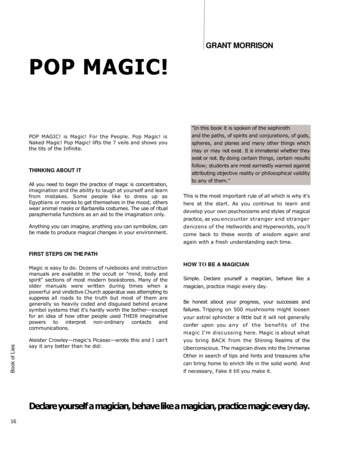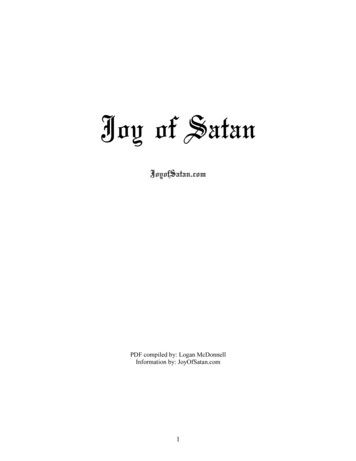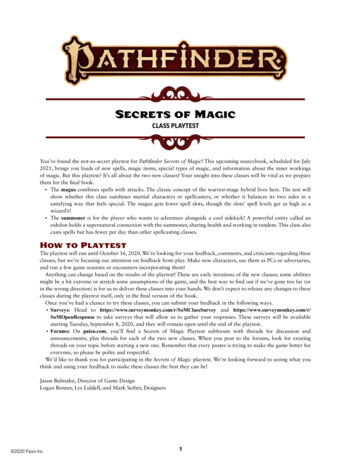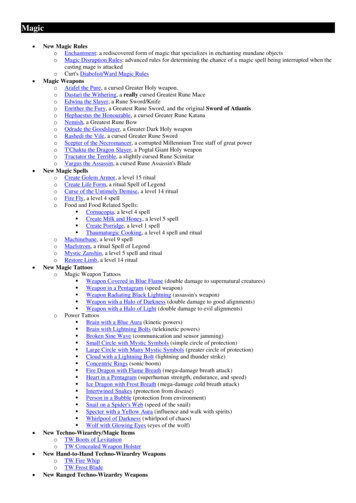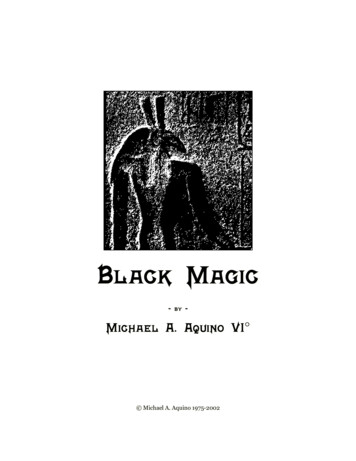
Transcription
Black Magic- by -Michael A. Aquino VI Michael A. Aquino 1975-2002
-1-Table of ContentsChapterPageIntroduction21: Origins of the Temple of Set52: Ancient Egypt and the Original Priesthood of SetSet10133: InitiationThe Concept of InitiationThe Two PathsInitiatory Degrees of the Temple of SetAncestry and Evolving Definition of the Grade Degree TitlesÆonsThe Pentagram of Set202022242533364: The Black Magical Theory of the UniverseWhat is “Theory”?Types of TheoriesThe UniverseThe PsycheThe Immortality of the PsycheThe Prince of DarknessThe Objective and Subjective UniversesThe Natural Approach to the Objective UniverseThe Non-Natural Approach to the Objective UniverseThe Natural Approach to the Subjective UniverseThe Non-Natural Approach to the Subjective UniverseComment: Setian Philosophy - Natural vs. Non-Natural Religion414141424447566364666667705: Lesser Black MagicEthics in the Use of Black Magic72756: Greater Black MagicMedial Black Magic8698Index100
-2-IntroductionWhy have you come to the Temple of Set? Presumably because:(1) You feel that there are metaphysical realities beyond the physical universe, andthat this possibility is sufficiently important to you for you to establish whether ornot it is true.(2) Religions and atheistic/materialist schools of thought to which you havepreviously been exposed have ultimately impressed you as inadequate to this task.(3) What you have heard and read about the Temple of Set suggests to you that it justmight have the keys to this puzzle.(4) Involved with such keys are unusual skills that you may use, both in pursuit ofsuch metaphysical wisdom and in support of objectives in the physical universe.Most of the world’s conventional religions1 prefer influence over their membersfrom birth, so that they have the advantage of working with a “blank slate”. Knowingnothing else, the child is indoctrinated into the religion, taught that it is the true andonly answer to questions beyond tangible experience. If such indoctrination is strongenough, that religion will remain the metaphysical boundary for that individual for life.Using the implied authority of its superior vantage-point, moreover, the religion willattempt to dictate ethical and moral codes for the individual, inculcating feelings for“rightness” and “wrongness” that will flow into his personal behavior and the socialinstitutions he shares with others.The more primitive and closed the society, of course, the more effective andenduring such religious indoctrination will be. But at various times and circumstancesin history, such as the Greek Hellenistic and the Enlightenment eras, and in at leastcertain advanced cultures today, persons will eventually be exposed to other religions,and non-religions, besides the “inherited” one. The more inquisitive the individualconcerning metaphysical truth, the more he may “shop” among such alternatives,looking for the one with the [most] right answers.The Temple of Set not only does not indoctrinate anyone from birth, but it prefersto be at the end of an adult enquirer’s “shopping list”.The Setian religion is not something that either can or should be taken on faith, orin the controlled instruction of childhood, or as an antagonistic rebound from any otherreligion. To be apprehended, understood, and applied correctly, it must be approachedonly by individuals who have first examined and discarded as many alternatives aswere available and of interest to them. If any such alternative proved satisfying to anindividual, that signals to the Temple of Set that he does not possess the extraordinarydrive for metaphysical truth that is required for Setian initiation. He will be content and1What is “religion”? Cf. Vesa Iitti III , “On the Left Hand of Religion”, Scroll of Set #XXV-5(October 1999), in the Scroll Back-Issue Collection.
-3fulfilled at the level he has chosen; were he to attempt Setian initiation, he would soonfind it disturbing, stressful, and even frightening.So your suitability for Setian initiation hinges not only upon the importance of theabove four questions to you, but also upon the assumption that you have indeedexplored and exhausted as many simpler answers to them as possible. Collectively thisexperience will provide you a point of personal comparison from which to now evaluateSetian philosophy. Because it is no good if it doesn’t make sense to you, and for it tomake sense to you, you must be able to visualize and consider contrasts to it.Please take time to consider whether both of these suitability criteria - the fourquestions and a reasonable background of alternative experience - fairly and honestlyapply to you. If not, you may wish to turn away from the Temple of Set until/unless theydo. But if you feel that they do apply: Welcome to our Temple. Enter freely and of yourown will.The Temple of Set provides various publications and communications to presentitself and its knowledge to you. At all times it it your responsibility not only to read andconsider such information, but to judge it as it is intelligible and relevant to yourself.The importance of this responsibility cannot be overemphasized. The Temple is avehicle to aid you in your personal initiation, so at all times your own comprehension,understanding, and evaluation of your own state of being are essential.The Temple of Set is committed to the most direct and intelligible presentation ofits philosophy possible. Every effort is made to define terms carefully, to avoidvagueness and logical fallacies, and to address important issues squarely. We emphasizethis to a degree unmatched by conventional religion, by the “occult subculture”, andindeed by most of the academic philosophical community.Even so we are beset by three continuing difficulties:(1)Our knowledge base is incomplete and in many cases insufficient to answercertain questions definitively. In such situations we offer what seem to be themost promising theories and hypotheses, and encourage the open exchange ofideas towards the eventual truth.(2)We exist in a society that, despite its announced commitment to truth andfreedom of expression, contains many taboos, morals, and prejudices which makeeven the discussion, much less the advocacy of certain ideas awkward andoccasionally dangerous - even if the ideas in question happen to be logically orfactually valid.Since the Temple of Set is “open to the public” as a formal, legally-recognizedreligious institution, we must take appropriate care to retain the respect andtolerance of the community in which we exist.So, while we must and will not shrink from asserting truth as we discover it,we also attempt to do so publicly in ways that will be understandable to thatpublic, and in support only of constructive, non-harmful applications by it.(3)For the first two decades after its founding in 1975, the Temple of Set waspredominantly first an American, then an English-speaking internationalinstitution. With the turn of the century, and in no small part to the influence andconvenience of the Internet, we are now a presence in many non-English-
-4language cultures. Beyond the task of direct dialogue, we face the challenge oftranslating Setian philosophy into non-English languages and idioms. Fortunatelymany such natives have acquired some fluency in English, and can help to bridgethis gulf more accurately and empathetically than the Temple itself couldoriginate. Nevertheless we must remain alert to this difficulty, and seek tominimize it as best we may.Black Magic is the introductory section in the Crystal Tablet of Set, which is thefirst volume in the Jeweled Tablets of Set series - a sort of “encyclopædia” of Setianinitiation, whose progressive jewel-colors reflect the medallions of the respectivedegrees. Thus the Ruby Tablet pertains to Adepts II of the Temple, the Onyx Tablet tothe Priesthood of Set III , the Sapphire Tablet to the Masters of the Temple IV , theAmethyst Tablet to Magi V , and the Topaz Tablet to Ipsissimi VI .Black Magic presents the Temple of Set’s philosophy in its most elemental form. Ifit makes sense to you here, then it is probable that you will derive increased pleasureand satisfaction from the Temple as you proceed further into its initiatory system. If onthe other hand you find that you are having difficulty with these basic propositions, or ifyou find them unsatisfactory or unconvincing, then it is an indication that you shouldprobably seek out another religious or philosophical environment for personalexploration and expression.
-5-Chapter 1: Origins of the Temple of SetThe story of the Temple of Set which you have entered begins in 1966 of whatarchæologists, in an effort to be non-sectarian, refer to as the Common Era (CE). In thatyear a man named Anton Szandor LaVey founded the Church of Satan in San Francisco.LaVey, an imposing, congenial man with a carnival and circus background, had formany years been an enthusiastic but cynical devotee of the occult. He accumulated aunique library containing many works on the more peculiar and obscure facets ofhuman nature, together with the major classics of traditional occultism. Disappointedwith the lack of sophistication and practical relevance he saw in existing occultorganizations, he decided that he would have to start one of his own to remedy theproblem.In the early 1960s, therefore, he began to conduct “midnight magic seminars” athis home in San Francisco’s Richmond District. By 1965 these had solidified into aformal “Magic Circle”. The success of this Circle prompted him to found the Church ofSatan on Walpurgisnacht (April 30) of 1966, which henceforth became known as theYear I Anno Satani (AS).For the first four years of its existence, the Church remained essentially a SanFrancisco organization. Group rituals were held every Friday night at midnight at theLaVey residence, while during the week Anton gave lectures on various arcane subjectsand taught classes to aspiring Witches and Warlocks.This fascinating and controversial organization won its share of publicity aroundthe country and abroad, and soon many curious individuals were writing to SanFrancisco to find out how they too could become Satanists. In 1970 Anton published theSatanic Bible (#6K) to summarize the basic tenets of his philosophy.The Satanic Bible did not represent Satan and his fellow dæmons as actual“supernatural” beings, but rather as symbols and metaphors for hedonistic selfindulgence. Other religions in general - and Christianity in particular - were notconsidered to be deadly foes; instead they were mocked and dismissed as sanctimoniousand hypocritical frauds.The Satanic Bible went on, however, to promise results from the practice ofsimplified and standardized magical rituals. Such rites invoked Satan as well as variousother gods and dæmons from many mythological traditions, appealing for and/orcommanding their aid in curses, seductions, cures, and the like.There was thus an oddly-inconsistent feature to the Church of Satan’s philosophy:On one hand it professed psychodramatic atheism, while on the other it assumed theliteral existence of dæmonic personages with the ability to hear invocations and thedisposition to respond to evocations.By 1970 Anton LaVey and his wife Diane had begun to feel the strain of endlesshospitality, so a decision was made to cease most of the activities at their home in favorof sponsoring local units or “Grottos” of the Church elsewhere in the United States.From 1971 to 1975 the Church thus consisted of a San Francisco headquarters plus some
-6five to ten Grottos in various metropolitan areas.Over the years many rumors have circulated concerning the growth and size of theChurch of Satan. I have seen figures ranging upwards of 50,000 card-carrying Satanists,with several millions of sympathetic non-members waiting in the wings. In actuality theChurch rose from an initial San Francisco membership of about 50 to a nationwideaverage of about 300 through 1975. There was a turnover of perhaps 30% per year,reflecting the casual, fickle attitude of many of the lower-level members.By 1973 Grottos had been organized in San Francisco, Santa Cruz/San Jose, LosAngeles, Denver, Dayton, Detroit, New York, Louisville, and Washington, D.C. Like themembership-at-large, these tended to be unstable, short-lived groups, surviving andprospering only as long as a charismatic Grotto Leader was in office.By 1975 Anton LaVey, having presided over nine years of mercurial individuals andGrottos, reluctantly concluded that, while the philosophy of Satanism had lost none ofits popular appeal, the Church of Satan itself was largely a failure. A small, stablenucleus of serious and sincere devotees had indeed developed, but for the most part theChurch had served to attract merely fad-followers, egomaniacs, and assorted oddballswhose primary interest in becoming “Satanists” lay in being able to flash theirmembership cards for cocktail-party notoriety. Anton decided that the Church might aswell be converted to a vehicle for his personal financial benefit, hence in May of 1975 heannounced a decision to sell the Satanic Priesthood and all higher degrees for funds orobjects of value.Upon founding the Church, Anton had claimed for himself the titles of High Priestof Satan and Magus of the Age of Satan. By 1969 he had begun to ordain others to theSatanic Priesthood (the Priesthood of Mendes), and in 1970 he formalized an initiatorystructure of five degrees: Satanist I , Witch or Warlock II , Priest or Priestess of MendesIII , Magister IV , and Magus V . Advancement to the II was based upon a fairlyelementary examination concerning the contents of the Satanic Bible, but Anton wasextremely strict concerning ordination to the Priesthood. Perhaps twenty individualsattained the III between 1966 and 1975, while during the same period Anton conferredonly four IV s - one of which upon myself.Anton’s 1975 decision to sell the degrees confounded the nucleus of sincereSatanists, myself included, who saw in it a critical corruption of the very institutionwhose incorruptibility and condemnation of hypocrisy had made it so refreshing andexhilarating.Seizing control of the Church was impossible; Anton had incorporated it under hisexclusive, personal control in 1971, a time when none of us had remotely anticipated his1975 decision. Our only option was therefore to leave. By mid-June 1975, therefore,virtually the entire nationwide Priesthood of the Church had resigned en masse. TheChurch of Satan as a viable, functional organization was dead, save that the LaVeyscontinued to use the corporate name and image for private gain as a “businesspartnership”, a status upon which they formally agreed by contract in 1985.In 1988 Diane [LaVey] Hegarty sued Anton to dissolve the business and divide itsassets between the two of them, and this was so ordered by the San Francisco SuperiorCourt on October 28, 1991. Anton subsequently filed for bankruptcy for himself and the
-7Church of Satan, and the U.S. Bankruptcy Court so ordered, under the dissolutionChapter 7 of U.S. bankruptcy law, on April 29, 1993. Legally as well as essentially andorganizationally, therefore, the Church of Satan no longer exists, though continuingattempts to exploit its name might pretend otherwise.The other three Masters of the Church had all turned tail in June 1975: One,Charles Steenbarger, was a clinical psychologist in Denver who feared that any but themost furtive involvement would wreck his life and reputation; the second, John Ferro,was a self-acknowledged decadent who could not bring himself to take any stand againstAnton LaVey; the third, Anthony Fazzini, was the LaVeys’ chauffeur, whoseappointment to the IV a few months earlier had itself been a scandal foreshadowing theJune crisis.As the senior initiate among those who resigned in 1975, therefore, I was looked tofor an answer as to what to do next. Should we try to form a “Second Church of Satan”,or was the disaster so overwhelming that any such reconstruction would be futile?In a Working of Greater Black Magic on the night of the North Solstice (June 2122), I evoked the Prince of Darkness himself. “If this is not the end,” I said, “tell us whatwe may do to continue our Quest along the Left-Hand Path.”The result of the North Solstice Working was a document entitled The Book ofComing Forth by Night, professing to be a communication from the Prince of Darknessin his original semblance as the Egyptian god Set. The Æon of Horus and theintermediary Age of Satan were at an end; the Æon of Set had now Come Into Being as acatalyst for a new evolution of the Elect of mankind. We were charged to found a Templeof Set to replace the Church of Satan, and I - like Anton LaVey before me - wasRecognized to the degree of Magus and directed to assume the High Priesthood.As with any Greater Black Magic (GBM) working, the Book of Coming Forth byNight will assume different significance to different people. Skeptics might consider itmerely a work of fantasy or self-delusion; religious fanatics a message from theJudæo/Christian Devil; old-time occultists an imitation of Aleister Crowley’s Book of theLaw.There is nothing to gain by debating such points of view. As is discussed later inBlack Magic, any GBM working is necessarily a supra-rational experience, not a logical,scientific, or artistic exercise. It will be most meaningful to its celebrant, and it may ormay not be meaningful or even intelligible to others.What I will assert is that, as far as I myself am concerned, the Book of ComingForth by Night was and remains authentic: the nœtic apprehension of an intelligence“beyond myself” which reduced certain statements, judgments, principles, and symbolsto a text.This text was so meaningful to me that I have since ordered my life and philosophyby its principles. The other founders of the Temple of Set accorded it a similar trust andrespect. Even though they had not participated in the working itself, many remarked,they felt that the text itself carried its own aura of authenticity and conviction. In theyears that followed, countless others have been moved by it in a similar fashion.When I accepted the Book of Coming Forth by Night, it was in a deliberate,reflective way - with a resolve to undertake the creation and care of the Temple of Set
-8proper, and to patiently allow history to validate or disprove any principles that theTemple might propose or practice. This has remained my attitude ever since that sereneand sublime experience.As for the text itself, I am content to comment upon it as best I can, then let othersjudge it as they will. For me it is now, as then, a simple, beautiful, and purposefulstatement from the sentient being whom mankind has loved, hated, worshipped, cursed,praised, and reviled as the Prince of Darkness. To echo the words of G.B. Shaw in TheDevil’s Disciple: “I promised him my soul, and swore an oath that I would stand up forhim in this world and stand by him in the next.”I commenced to Recognize the five most accomplished Priests and Priestesses ofthe Church to the IV : Robert Ethel of the Asmodeus Grotto, Washington, D.C.; MichaelGrumboski of the Phœnix Grotto, Detroit; L. Dale Seago of the Yuggoth Grotto, LosAngeles, Lilith Sinclair of the Lilith Grotto, New York City; and Margaret Wendall of theBubastis Chapel & Karnak Grotto, San Jose. We formalized the Temple of Set as a nonprofit, incorporated church in California, and by October had qualified for federal andstate tax-exempt status. A board of directors - the Council of Nine - was instituted, and asystem of local Pylons was established to supersede the old Grottos.In addition to its emphatic stance against the sort of corruption and confusion thathad brought about the downfall of the Church of Satan, the Temple of Set differed fromits predecessor in a number of ways. The Church had always courted the public eye; theTemple refused all but the most necessary publicity. The Church had been arrogantlysensationalistic; the Temple was cautiously philosophical. The Church had opened itsceremonies to visitors, reporters, and academic researchers; the Temple’s activities werecompletely closed to non-Initiates. All degrees in the Church had been conferred byAnton LaVey personally; in the Temple the Recognitions of Adepts II and of thePriesthood of Set III were entrusted to the Priesthood and Masters respectively.Doctrinally the Temple confronted a number of challenges with which the Churchof Satan had never had to deal. First and foremost was the proposition of the very literalreality of Set. Gone overnight was the shaky conglomeration of half-baked anti-Christiandæmonology; in its place was a new conceptualization of the Universe which wouldgradually mature into the perspective summarized later in this essay.The guiding Word of the Age of Satan - Indulgence - had exhorted Satanists toremain satisfied with a hedonistic approach to an admittedly animalistic life. The Wordof the Æon of Set - Xeper - held out the promise of an evolutionary divinity to thoseintelligent, bold, and determined enough to attain it. From a simple, colorful, and easygoing Church of Satan there had emerged a Temple of Set which was bewilderinglycomplicated, socially obscure, and impatient with complacency.During its first four years the Temple of Set maintained an average membership ofabout 100 Initiates, almost all of whom were former members of the Church of Satan.Membership solicitation was felt to be inconsistent with the esoteric atmosphere of theTemple and the intrinsic dignity of true initiation. It proved to be very difficult,moreover, to institutionalize a philosophy as complex and undeveloped as ours. Nostandardized instructional courses were offered, and any sort of “enthusiastic butignorant followers” climate was quite unacceptable. Hence we weren’t at all certain that
-9it was a good idea to encourage aspirants who didn’t have an a priori workingrelationship with a Priest or Priestess through a local Pylon.Back issues of the Scroll of Set, which you may acquire as explained elsewhere inthe Crystal Tablet, will take you on a magical mystery tour of the sometimes thrilling,sometimes painful, always interesting odyssey of the Temple to the present day. Thepicture will emerge of an organization very wise in some ways, surprisingly naïve inothers. These are the adventures of the Elect of Set, who are exploring a strange andunprecedented perspective on existence. You are welcome among them: to Will, toKnow, to Dare, and to Speak.In a world smothered by ignorant, fearful, predatory, and hypocritical confidencegames masquerading as religions and ideologies, the Temple of Set stands alone andapart - as Set has always stood alone and apart from the careless savagery, the purehazard that is the natural state of the objective universe. Whether you realize it yet ornot, you have opened a door that leads not into a building of marble or stone - but intothe wonders of your own divine soul.
- 10 -Chapter 2: Ancient Egyptand the Original Priesthood of SetThe earliest existing evidence of human culture in the Nile valley dates to morethan 250,000 BCE, as the remnants of handaxes and other stone tools have beenuncovered 50-100’ below the Nile’s silt terrace.Sometime between 10,000 and 7,000 BCE, according to conventional archæology,a most important event took place - the domestication of the wild African goat and thesubsequent freedom to begin cultivation of grain. This effectively heralded the beginningof human civilization, as for the first time primitive man was free to turn his thoughts tomatters other than a constant search for food.2Inhabiting a land characterized by the regularity of the elements (behavior of thewinds, the Nile, the climate, the Sun, and the skies), the Egyptians sought perfection instability, harmony, symmetry, geometry, and a cyclical [as opposed to progressive orlinear] concept of time.(#20B) Egyptian achievements, correspondingly, were notable inareas such as astronomy, mathematics, medicine, and architecture.Egyptian religion and art tend to be oversimplified in many modern treatments,due in part to the absence of verifiable data in later history until the deciphering ofhieroglyphics by Champollion in 1822. Because of the destruction and despoliation ofancient Egyptian records and works of art by religious fanatics of later eras, it isestimated that modern archæologists have at their disposal less than 10% of thatcountry’s cultural creations from which to reconstruct its values.3The Egyptians perceived the Universe as actively controlled by conscious, naturalprinciples (neteru) of which Sir E.A. Wallis Budge remarks:The word neter has been translated “god-like”, “holy”, “divine”, “sacred”,“power”, “strength”, “force”, “strong”, “fortify”, “mighty”, “protect”; but it is quiteimpossible to be certain that any word which we may use represents the meaning ofneter, because no one knows exactly what idea the ancient Egyptians attached to theword. The truth is that the exact meaning of neter was lost at a very early period ofEgyptian history, and even the Coptic does not help us to recover it.4To the Egyptians, all of “nature” (derived from neter) was alive and the directconsequence of the wills of the neteru. Nature was intelligible not just throughinanimate, automatic, general regularities which could be discovered via the “scientificmethod”; but also through connections and associations between things andevents perceived in the human mind. There was no distinction between “reality”and “appearance”; anything capable of exerting an effect upon the mind thereby existed.Fairservis, Walter A. Jr., The Ancient Kingdoms of the Nile. New York: New AmericanLibrary/Mentor #MY-843, 1962, Chapters #1-2.3Cf. Fagan, Brian M., The Rape of the Nile. New York: Charles Scribner’s Sons, 1975.4Budge, E. A. Wallis, The Book of the Dead. New Hyde Park: University Books, 1960, page #99.2
- 11 Hence a dream could be considered just as “real” and thus significant as a daytimeexperience.Egyptian art, literature, and science looked for beauty and symmetry (felt to beindications of divine perfection), rather than for cause-and-effect relationships. HenceEgyptian thought is sometimes called “geometric” as opposed to the “algebraic” thoughtof Hellenic and later logicians.Since impressions and appearances substantiated reality, the Egyptian emphasison portraits and statues of the neteru was not merely decorative, metaphorical, orsymbolic. Rather an image was a medium whereby the neter in question could make anactual appearance in the material world.5 Similarly part of something could substitutefor the whole as long as the mind completed the connection. Mental imagery created byviewing the portrait of a dead relative, for example, brought that relative to true life.Egypt was divided into 42 nomes (provinces), each dominated by the priesthood ofone or more neteru. A particular priesthood might also dominate more than one nome.The monarchy was closely controlled by the various orders of priesthood, with thepharaoh acting as an Earthly deputy of and interpreter for the neteru. Governmental,judicial, and political systems were responsible for their ethics to the neteru, not to thepeople. Justice was meted out by viziers (internal roving ambassadors of the pharaoh)and nome governors according to the neter of justice, Maat, on an individual-case basis.There was no concept of individual rights against the government, because governmentwas viewed as a system imposed from without by the neteru. Similarly each Egyptian,whether high- or low-born, participated in this system. Crime and corruption were ofcourse possible, but inadvisable because of the conviction that vice would be punishedseverely after Earthly death.6Old Kingdom Egypt was largely insulated from foreign invasion or conflict, henceEgypt spent its early years as a peaceful culture with no standing military. Egypt iscredited with invention of the alphabet, as well as the use of currency as a medium ofexchange. It is noteworthy for having produced the first national (as opposed to citystate) political system, as well as the most enduring one in recorded history (more than3,000 years). There was no caste, racial, or sexual discrimination; foreigners wereconsidered “less than human ( Egyptian)”, but could remedy this misfortune simply bymoving to Egypt and adopting Egyptian culture.Egypt was ultimately destroyed by foreign conquerors (Persia, Macedonia, Rome)and her inability to adapt to the continuing competition of foreign cultures. Her NewEmpire of the Setian (XIX-XX) Dynasties was a protectionist backlash rather than aneffort to “civilize” or create a permanent empire [as per Persia, Macedonia, or Rome].Persons unfamiliar with the ancient Egyptian culture often assume that theEgyptian religion, like those of later Mediterranean civilizations, consisted of a single,integrated pantheon of anthropomorphic gods and goddesses. It is rather the case thatCf. Schaefer, Heinrich, Principles of Egyptian Art. (#2R) Oxford: Clarendon Press, 1974.Contrast Egyptian statuary with Greek, Roman, or later European. The “living presence” in theformer will be dramatically evident.6Wilson, John A., “Egypt” in Frankfort, Henri (Ed.), Before Philosophy. (#2B) Baltimore:Penguin Books, 1946.5
- 12 the earliest Egyptian neteru were provincial, being patrons of individual cities anddistricts (nomes). Nor, despite their famous human/beast composite appearances, werethey mere “supernatural persons” in the later Greek, Mesopotamian, or Roman mold.While popular stories were woven about them - presumably for popular consumption the hieroglyphic treatment of the Egyptian neteru suggests that they actuallyrepresented various aspects of existence - the “Forms” or “First Principles” discussed byPythagoras and Plato in a more abstract manner.7Intriguingly the neteru may have had a physical pre
Black Magic is the introductory section in the Crystal Tablet of Set, which is the first volume in the Jeweled Tablets of Set series - a sort of “encyclopædia” of Setian initiation, whose progressive jewel
